Porsche 911 Carrera shines, top or not
By John Gilbert
As twins go, sometimes not being identical is preferable. That’s certainly the case of the Porsche 911 Carrera, where the Summer of 2012 brought a pair of Porsches virtually back to back for test drives. One was a sleek, dark green Carrera S Coupe, and the other was a sleek, dark blue Carrera Cabriolet convertible.
That’s not to say I would have turned down a second chance in an identical Coupe, but the opportunity to take pretty much the same car and drop the top was the perfect complement in Minnesota’s heat wave.
Both test cars had Porsche’s superb 3.8-liter flat-opposed 6-cylinder engine, rear mounted and attached to a rear-drive arrangement. So when you pop the trunk, both can elicit more than just the usual rubber-necking gaze, because the trunk is in the front, and passers-by always seem puzzled that there is only a quite-deep well under the front hood, with no engine up there.
Visually, the newest generation of 911 doesn’t look completely different, as 30 years hasn’t required major alteration from the original design. But if the visual impact of a Porsche 911 has remained true, so has the audible sensation, which is at least as recognizable. Turn the key in the 911 and you don’t get a rumble, or a roar — you get an unmistakable snarl. Tap the gas pedal, and the snarl sounds more urgent, more seriously businesslike. Driving the car is an extension of that wonderful sound.
If you’re a casual driver wanting to just go from Point A to Point B, drive something else. If you enjoy driving, and you’re willing to pay attention to the requirements of driving, the Porsche will make you a better driver, and it will immediately convince you of the advantages of devoting full attention to driving a car from Stuttgart. There are no cupholders. And frankly, even in this era of constant rehydration, you probably won’t miss them. There is a new and impressive audio system in the car, but if you start driving without it, you might forget to turn it on. While the car turns you on.
Both the Coupe and Cabriolet ride on the new 991 series for 2013, with an elongated wheelbase, so both earn similar but slight gains in spaciousness and lack of harshness. The biggest difference between the two cars is obvious. In the Cabriolet, you hit a switch on the console, either while at rest or rolling slowly, and the top unlatches from the front and retreats — with efficient quickness — under a raised rear cover, up and locked to down and airy in about eight seconds. Same with going back up. I never really timed it, although there is a timing device in the car as well, but if you’re two-thirds of the way through a red light when you realize it’s drizzling, you can still hit the switch and close the top, tightly, before green. Putting it down is even better, but both put on a mini-show that other drivers seem to marvel at, or at least enjoy.
Both cars also have made a smooth transition from their iconic position to the future, which includes electronic gizmos helping to control everything from steering to suspension to spectacular PDK transmission shifts, to exhaust tone — and even to raising or lowering the little spoiler lip up from its nest on the rear engine cover.
It may seem reassuring that if you pay $126,000 for the 911 Carrera S, you can find 911 Carreras for less money, and also more money. Consider that you can get a 911 Carrera without the “S” for a base price of $83,050, and find a fully adequate base 3.4-liter 6 that has 350 horsepower and 287 foot-pounds of torque. Or you could move upscale, above the Carrera S, and for bout $175,000, get the Turbo S with a twin-turbocharged version of the 3.8 that delivers 530 horsepower and 516 foot-pounds of torque.
That flat-opposed engine design, with three cylinders going left opposite the other three pumping to the right, has powered Porsches forever. The flexibility of potential power is just an example of why it works so well. The Carrera S Coupe feels a lot like a LeMans race car that had its numbers and sponsorship logos peeled off, made a wrong turn, and now shows up in your driveway. Is that for real? Or is it a dream? If it’s a dream, I don’t want to wake up.
Porsche makes the 911 Carrera in small batches, and it indeed is built with race car precision and over-the-top engineering, then sold and sent out onto our streets and freeways, with full knowledge that no U.S. highway or freeway can offer what German autobahns can, which is unlimited speed limits. The Carrera S shows a manufacturer’s claim of a 188-mph top speed. We won’t question that, but it also might seem that whatever the top speed is, the Porsche Carrera 911 S will probably cruise at that limit all day on an autobahn.
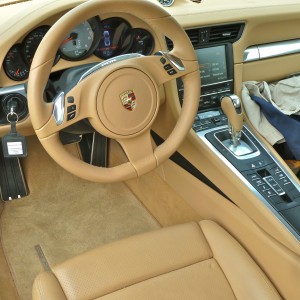
Classy interior is all business -- there are no cupholders, just controls to enhance driving enjoyment.
We in the U.S. are somewhat brainwashed into thinking that bigger is better when it comes to engines, and Corvette V8s have grown to the enormous displacement of 7 liters, and the new Shelby GT500 Mustang now challenges for 200-mph supremacy, while Dodge boasts of its huge Hemi. All of them, however, would give anything to run in a classic world endurance race and beat a 3.8-liter Porsche, which will run at top speed for hour, after hour.
The 911 Carrera S has 400 horsepower at 7,400 RPMs, and 325 foot-pounds of torque at 7,500 RPMs. Consider those peak-power revs and realize that the 7-liter Corvette Z-06 has a redline limit of 7,000 RPMs.
A Car & Driver magazine test showed the Porsche 911 Carrera S going 0-60 in 3.6 seconds, with the same PDK automatic that was in both test cars I had. The fact that I averaged from 25.3 to 26.0 miles per gallon with either car in combined city-freeway driving is also testimony to how Porsche is also paying attention to modern concerns about fuel-efficiency.
The PDK is Porsche’s recently introduced and long-awaited sequential-manual transmission, with seven gears and no clutch pedal. When it was first introduced, I had the chance to drive it on a road-racing course where it was proven to me that the 6-speed stick is a lot of fun to drive, and the PDK manually controlled with paddles on the steering wheel might be just as much fun, but the fastest way through all the varying turns to run a lap is by putting it in “D” and leaving it there, trusting the car and its electronics to shift for you.
It seems incomprehensible, but taking the driver out of the equation allows the PDK to send the Porsche 911 Carrera S around the track in the swiftest possible time. Briefly, the trick is inside the clutchless manual gearbox there are two clutches; one engages first, third, fifth and seventh, while the other grabs second, fourth and sixth.
As you accelerate hard in, say, third, the computer figures you’re going to upshift, so the disengaged clutch grabs fourth. When you force it to upshift with the right paddle, or when you just leave it alone, the transmission instantaneously switches which clutch is engages, and you’re in the next gear. As if to underscore how good the PDK is in D, when you’re driving along normally, you hear the tone change when it upshifts, but you feel nothing. No jerk, no hesitation — nothing. Just a chorus of horsepower singing in a higher octave.
It’s the same when you downshift with the left paddle, and it’s more remarkable when you let it do it automatically. You hear the blip as it revs the engine to match the upcoming gear, then it drops one, or maybe two, gears so that you’re in the perfect ratio for what it somehow knows is required.
That’s not all, however. There is a button right there on the console that says Sport, and if you push that, at any time, the shifts come quicker and hold to higher revs and everything is electronically firmed up. There is another button that says Sport Plus, and if you hit that one the upshifts and downshifts become significantly more abrupt and the firmness goes on toward race-track-only levels. Engaging Sport Plus means that when you step on the gas, even semi-hard, the engine revs build quickly and surely, and just as you think it’s not going to shift, it shifts — but not until it reaches redline.
I found that I had to engage Sport whenever I was driving, and sometimes I would hit the little button that also makes the exhaust note louder and clearer. Once in a while, I also hit the button to force the spoiler to lift up off the rear deck. Not that I ever pushed the car hard enough so the spoiler would make a difference in stability, but frequently people in sporty, normal, and even mundane cars, and in bulky SUVs, would see the Porsche near them on the freeway and decide they could prove something about themselves by zooming past you.
Sometimes it gets tiresome when someone in an Equinox speeds up to make a dramatic pass, as you think you don’t care how fast they want to go, they then swerve in front of you to exit. That’s rude, and after it occurs a few times, you might want to blip the gas, zip back ahead, then hit the switch for the spoiler to rise. Sort of like letting the Porsche flip them off, so you won’t be tempted to.
Nobody has ever accused a 911 Carrera of anything other than fantastic handling. The car can be bought with all-wheel drive, and that is truly remarkable, because as is, the rear-drive power can push the Porsche to the point where the tail might want to wag the dog. That would be at some excessive speed, of course, beyond the realm of daily driving. But the new car gains a feeling of extra stability from the new platform, which provides a bit more roominess inside without lengthening the car itself.
The rear seat folds down, but, of course, we’re calling it a rear seat in the loosest of definitions. It looks like a seat, is shaped like a seat, but if you have the front seats pushed back, there is precious little legroom back there. Several folks I gave rides to mentioned that no adult could really fit back there, and I developed a standard response: If you move the front seat forward, you could get barely adequate rear seat legroom, and besides, would you rather ride in such cramped conditions or stay on the sidewalk and watch the Porsche 911 Carrera S swiftly spend that snarl and disappear over the horizon? End of discussion.
The convertible 911 Carrera has the same rear seat, with a couple other issues. While cruising at freeway speed, you can get to notice some wind buffeting, common to all convertibles. In the Porsche, another little switch near the exhaust and sport buttons will cause a neat little screen to fold up and stand vertically behind the front buckets to deflect and use up that buffeting energy of the wind outside.
The top clicks into place tightly and securely, and if you hold the button, it also will raise the windows afterward. A secondary button just shy of the window switch can be clicked, then the window switch will close or open the tiny rear vent windows.
The seats themselves comfortably enfold the front occupants, and you can drive for hours without feeling anything resembling fatigue. Of course, the driver has the advantage of scanning the large and clear instruments. As usual, Porsche engineers are aware that engine speed is more important than vehicle speed, and while your friendly local highway patrolman might disagree with that philosophy, the driver looks ahead at a large tachometer with its 7,500 RPM redline, while the 200-mph speedometer is smaller, and off to the left side.
My biggest problem with the convertible is that I had to drive from Duluth to Minneapolis on Interstate-35 where a construction slowdown became gridlock, and we sat, inching ahead in minute amounts, in the 90-degree heat. I knew the sun was bright and turned up to broil, but I had a Porsche cap on, and sunglasses, and besides, I wasn’t going to give in and raise the top. It wasn’t until a couple days later that I realized that my lower lip was sunburned to the point of cracking and stinging every time I smiled, or tried to talk. If I had it to do over again, I still wouldn’t raise the top. I only had the car for a week, after all, and what’s a little sunburn?
Comments
Tell me what you're thinking...
and oh, if you want a pic to show with your comment, go get a gravatar!


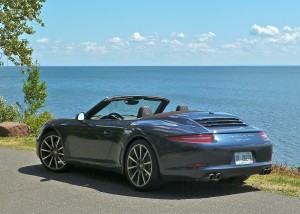
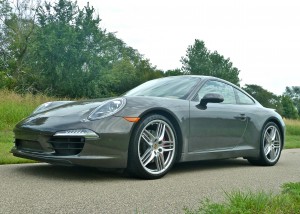
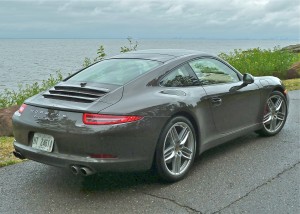
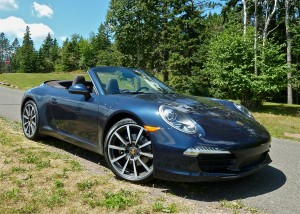
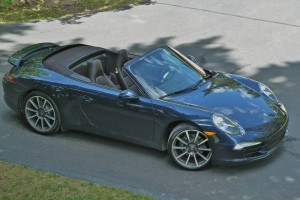
 John Gilbert is a lifetime Minnesotan and career journalist, specializing in cars and sports during and since spending 30 years at the Minneapolis Tribune, now the Star Tribune. More recently, he has continued translating the high-tech world of autos and sharing his passionate insights as a freelance writer/photographer/broadcaster. A member of the prestigious North American Car and Truck of the Year jury since 1993. John can be heard Monday-Friday from 9-11am on 610 KDAL(www.kdal610.com) on the "John Gilbert Show," and writes a column in the Duluth Reader.
John Gilbert is a lifetime Minnesotan and career journalist, specializing in cars and sports during and since spending 30 years at the Minneapolis Tribune, now the Star Tribune. More recently, he has continued translating the high-tech world of autos and sharing his passionate insights as a freelance writer/photographer/broadcaster. A member of the prestigious North American Car and Truck of the Year jury since 1993. John can be heard Monday-Friday from 9-11am on 610 KDAL(www.kdal610.com) on the "John Gilbert Show," and writes a column in the Duluth Reader.